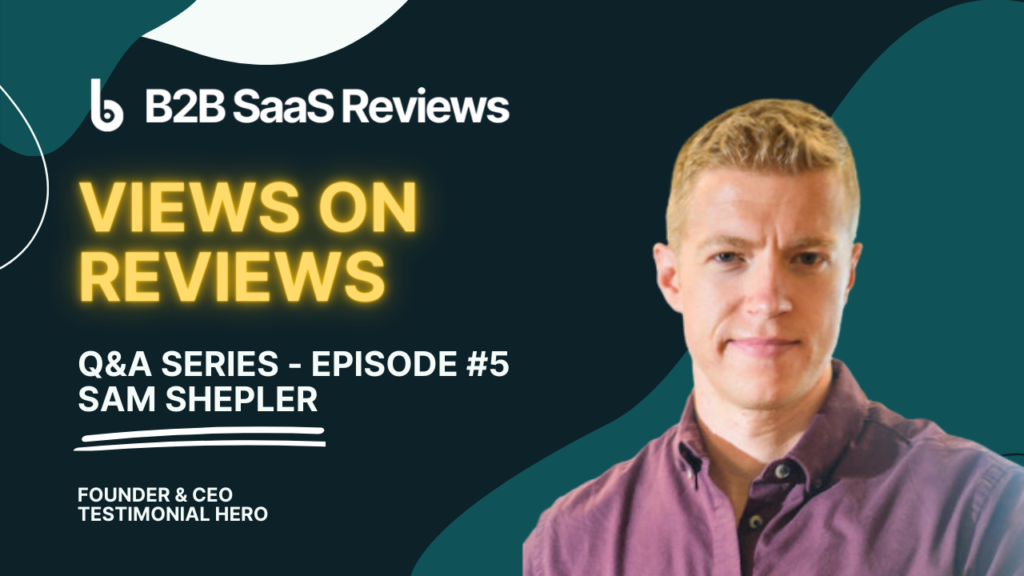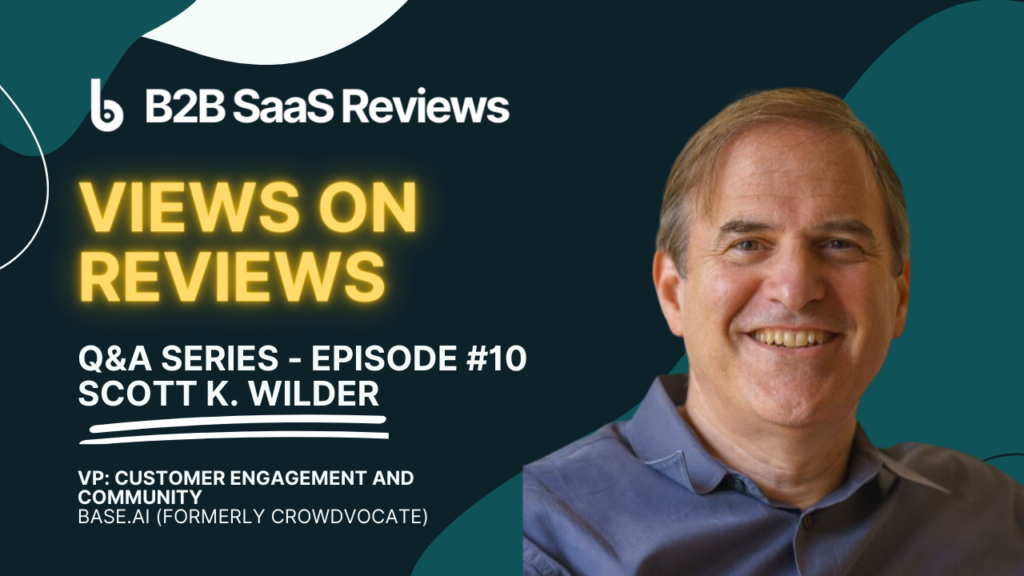Views on Reviews is a new series of interviews with B2B SaaS professionals who will provide a real-world perspective on what it’s like working on reviews. My fifth interview is with Sam Shepler, Founder and CEO of Testimonial Hero.

Sam Shepler is the Founder & CEO of Testimonial Hero, a video testimonial creation service for B2B software marketers. Testimonial Hero helps HubSpot, UiPath, Medallia, Hopin, and many other B2B SaaS stars let their customers shine in video testimonials.
Sam and his team helped bring several of PartnerStack’s customer success stories to life, including Aircall, CallRail, Gorgias, Monday.com and Omnisend.
Let’s see Sam’s views on reviews.
1. You’re the founder of Testimonial Hero. Can you tell us the abridged version of your founder story, specifically the market need you saw for video testimonials in B2B SaaS?
Answer: Before I was running Testimonial Hero, I was running a more generalist video marketing agency. One thing that became apparent to me after getting exposure to a lot of B2B SaaS clients was that customer storytelling was becoming increasingly essential. I could see the shift coming from working with our customers where we were transitioning into an age where marketing was going to become much more about making your customer the hero of the story. Simultaneously, there was also a major groundswell around the power of video for telling high-impact, engaging and emotional stories. It was really the combination of those two things that led me to start Testimonial Hero. I saw a big opportunity to help B2B marketing teams and support them with their customer storytelling, via video—plus it was something I was passionate about—so it seemed like a good opportunity to tackle
2. One of the challenges that you’ve highlighted B2B businesses having with customer reviews is simply bringing them to life. We explored that together in the blog post How to Combine Testimonials, Case Studies and Reviews to Create Powerful Social Proof. Can you elaborate on why video testimonials help bring written reviews to life?
Answer: Absolutely. There’s a lot of reasons, but one of them is simply the inherent benefits of the medium of video. Reviews are fantastic and absolutely need to be a part of everyone’s advocacy strategy, but also—you don’t get tone through text. With video testimonials, you’re able to actually feel a person's emotions and see and hear them light up. There’s a trustworthiness there that really is unmatched, aside from getting someone on a 1-1 reference call. Video testimonials are also a bigger time commitment for the testifying individual, so because of that, there is an even higher social proof index. Also keep in mind, a lot of reviews are fully or partially anonymized. Buyers know that if someone is taking the time to put their face and their whole reputation on the line for you in a video testimonial, they really stand by their endorsement. There’s a lot of power in that.
3. You host a podcast, The State of Customer Storytelling. Now that you’re 23 episodes in, what learnings have your guests shared on or related to the topic of reviews?
Answer: I think one of the biggest learnings (which we also hit on in your blog post as well) was around how well they can play together. Both in terms of mining your reviews for great stories to actually follow up on and turn into video testimonials, and actually repurposing the transcript of a video testimonial into review content. When you transcribe a video testimonial interview—which we always do for all of our customers at Testimonial Hero—you can then clip out parts of that transcript and see if your customer is also willing to use that text to complete their review.
4. One of the most used and possibly overused words right now in B2B SaaS marketing is “authenticity”. Some seem to suggest that “unpolished” means “authentic”. What does authenticity mean to you? And what makes for an authentic customer testimonial or review?
Answer: I love this question. To me, it’s primarily about the delivery and the way the content is presented by the testifying customer. If you try and script your customer too much, it’s never going to be authentic, even if you’re creating something unpolished. On the other hand, you can have a very high production quality video and a very authentic, natural story because you asked good open-ended questions and didn’t try to lead your customer too much down a certain path. If you look a little deeper, you’ll see that everyone pushing the “unpolished is better because it’s more authentic” storyline has an agenda. They are likely selling you a product or service that helps you create unpolished video. So sure, of course they are going to spin that narrative. The reality is, both polished and rough video testimonials can be authentic. And both polished and rough video testimonials can be extremely in-authentic. It really comes down to the audience being able to answer the question “is this extremely credible, is this a genuine opinion or is this too forced or scripted?” Then, with that in mind, you have to consider the different utilities that production quality extends. If you’re a billion dollar company, you’re probably not going to want to put a really rough but authentic video on your homepage, or play it to kick off your global event, or have it be a keystone of a large paid ad campaign. So all things being equal, when a video testimonial is both high quality and authentic, you’re able to use it in many more places in your marketing funnel. That is why you may want to focus on both quality and authenticity. They aren't mutually exclusive and they give you more options for how and where you can use said video.
5. Measuring the value of testimonials and reviews can be tricky. How do you advise your B2B SaaS clients to measure it?
Answer: The best way I’ve heard it put is by Gong CMO Udi Ledergor. The following is a direct quote from him and I couldn’t agree with it more: “We don’t obsess about attribution and ROI for everything we do in marketing. We are very numbers oriented, but there are things that you do because they just make sense, and you can feel their ROI without having to perfectly measure them. Everytime we’re at a crossroads and we have to make a decision between doing something I know will be effective and doing something that will be easy to measure, I will go for what I believe is going to be more effective. If you only do what can be perfectly measured, you’re missing out on a lot of the amazing marketing stuff you can do. There are things that you do just because they make solid business sense. Anyone who’s worked with sales knows that the number one thing they want from marketing is case studies. They want a case study for a referenceable customer within the same industry, geography, customer size, buyer persona, and that’s going to help them close a deal. It’s going to help them open a door, and have a conversation. So go get them that case study, even if you can’t perfectly measure it. If your sales leaders are thanking you for it and telling your CEO that they got what they needed from you, and it’s helping them close deals, that’s all the attribution you need.”
6. As a Founder and CEO, how do you “sell” the idea of investing resources in customer testimonials to your founder and CEO peers? And what questions do they typically ask?
Answer: I honestly don’t try to sell them on it too much—maybe I should think about doing more of that though! But I would say, how I would sell it would be simply asking them, what would the value be of taking every single question, fear, and doubt you run into in your sales process… for every single buyer persona, industry, etc… and having a pierce of video content to address those QFD’s from the perspective of a real customer? Pretty darn valuable to reduce uncertainty, drive decision making, and accelerate revenue.
7. B2B Marketers often look to B2C Marketers for inspiration. Do you see anything in today’s B2C customer storytelling that B2B Marketers should look to incorporate into their own customer storytelling?
Answer: One thing B2C does really well is volume. And it’s worth noting, there is implicit social proof in volume. Even if your prospect doesn’t watch all the videos, the fact that you’ve been able to accrue that many videos, considering the relative time and effort it takes to appear on video, there’s a very high social proof index there. So in that sense, B2C really nails the high volume of video testimonials and video reviews. You’ll have products where there are pages and pages of video testimonials in B2C. So I think that would be the main takeaway. Yes, content matters above all but let’s not forget that there is an implicit increase in trust associated purely with volume as well. Of course, those people still need to be relevant, ie the correct persona. But overall, there is a lot of power in having a greater number of video testimonials for any given customer segment than say, your competition.
8. You’ve added G2 reviews to the Testimonial Hero Customers page. Can you tell us about how that came to be?
Answer: Great question—that was primarily because honestly so many written testimonials are basically faked or written by the marketing team and then signed off on by the customer. We absolutely did not want to do any of that. So we wanted a way for prospects to see more verification that these are real reviews.
9. How does Testimonial Hero approach review generation on G2? And does Testimonial Hero generate reviews on any other reviews site?
Answer: We’ve focused primarily on G2 though we plan to expand to other sites as well. Given we are a video testimonial service, I would say we are much more sophisticated with our video testimonial programs and still have a lot to learn with G2 and written reviews. That being said, it’s mainly following up manually with customers at the right time. All of our G2 reviews are organic and manual. We actually don’t pay for G2, so we aren’t able to run large scale automated review gathering campaigns. Fortunately, we haven’t found that to be a huge problem since we have a lot of happy customers who are more than willing to take the time to write us a review.
10. With testimonials and reviews going hand in hand, have you explored or would you be open to partnering with any of the business software review sites?
Answer: We would 100% be open to partnering with a review site. It’s something we’ve explored with several of them, and we might have something in the works for later this year. Unfortunately, I can’t say any more that that at this time. We’ll see!
11. You shared a great tip on how to use video testimonials to also get more 3rd party reviews. What other tips do you have on how to ask for a testimonial or a review?
Answer: I think it’s also really important the language you use and how you frame the ask. I always make sure to not be assumptive in the ask, like you assume they will do it. I come from a place of genuine curiosity and see if it’s something they’d be up for, and take it from there. Secondly, I always tell them how long they should expect it to take. Lastly, I also make sure and let them know why it will be very helpful, how it will help us. Giving a bit more context around why we’re asking at this moment in time seems to make people more willing to essentially do us a favor.
12. When deciding who to ask for a testimonial, what criteria do you recommend B2B vendors use?
Answer: This is a great question. First you want to start with aligning on the strategic priorities of the business at the executive or revenue leadership level. Are we trying to grab market share in a specific segment? With a specific product line? That sort of thing. Then, once you’re clear on the priorities, you want to figure out where the gaps in your customer stories are. And then you can rank and prioritize them. It’s especially valuable to get your sales team involved here and make sure they confirm which personas, use cases, objection crushers, and industries would be most valuable to them. Because your time and resources are limited and you want to work from a place of maximum leverage. So you want to figure out which customer stories and objection crusher stories in which industries and personas will have the most value right now? Small hinges swing big doors. Start with those high leverage personas and use cases first and foremost that best align with your overall go-to-market and key strategic initiatives.
Key Takeaways:
- Written reviews are fantastic and need to be a part of everyone’s advocacy strategy, but tone can get lost in text. With video testimonials, you can actually feel a person’s emotions and see and hear them light up. There’s trustworthiness there that is unmatched, aside from getting someone on a 1-1 reference call.
- Video testimonials and written reviews play well together. As a vendor, you can mine your written reviews for great stories to follow up on and turn them into video testimonials. You can also repurpose the transcript of a video testimonial into written review content that you can share with a review candidate.
- Authenticity in video testimonials comes down to the viewing audience being able to answer the question, “Is this credible? Is this a genuine opinion, or is this too forced or scripted?” The production value of the video is irrelevant to its authenticity.
- B2C marketers use the power of reviews and testimonial quantity to create more social proof. There is strength in numbers.
- When asking for a testimonial or a review, come from a place of genuine curiosity, tell the customer how long they should expect it to take and why it will help.
- Include Sales when you’re deciding which customers to ask for reviews. Sales can tell you which industries and personas will have the most value right now.
It’s also worth noting that if you need to make an edit to a video testimonial, you can on your own with a tool like InVideo.
Do you have follow-up questions for Sam? Add and message him on LinkedIn. To learn more about Testimonial Hero, visit their site.
If you’d like to share your experience generating, leveraging, or measuring B2B SaaS reviews, please email me: joe@b2bsaasreviews.com
Authors
-

I'm the Founder and Editor-In-Chief of B2B SaaS Reviews and the Director of Demand Generation at PartnerStack, the leading platform for partner management and affiliate marketing in B2B SaaS. My experience spans several notable B2B SaaS companies, including Influitive (Advocate Marketing), LevelJump (Sales Enablement, acquired by Salesforce), and Eloqua (Marketing Automation, acquired by Oracle). I hold a Bachelor of Commerce in Marketing Management from Toronto Metropolitan University and a Master of International Business from Queen's University, with academic exchanges at Copenhagen Business School and Bocconi University.
-





